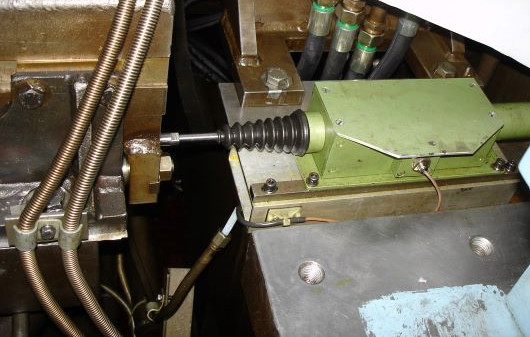Full service for run monitoring on turbines and power plants
MESSOTRON offers you a comprehensive installation and power plant service in the field of vibration monitoring, measured value acquisition, condition monitoring and speed measurement on power plants. The services include disassembly / assembly, testing, maintenance and commissioning of sensors and the associated transmitters and evaluation cards on gas / steam turbines and hydroelectric power plants, as well as all auxiliary power plant equipment.
- Professional disassembly of the sensors at the beginning of an overhaul.
- Installation of encoders, transmitters and control technology components
- Functional testing for displacement / speed / vibration sensors
- Control cabinet installation and cable routing to the machine / system
- Measurement of sensor characteristics, static / dynamic testing on site
- Carrying out tests and calibration of sensor technology in the laboratory
- Retrofitting or conversion of existing systems (assembly, function check, commissioning)
- Manufacturer-independent procurement of OEM and spare parts
- Troubleshooting and commissioning of control equipment
- Planning and production of special and add-on parts
- Preparation of test reports



Absolute casing expansion
The absolute elongation or absolute casing elongation is the free elongation of all turbine casings in the string in relation to the fixed point in the foundation. In the case of multi-housing turbines, the fixed points of the individual housings are arranged differently and coupled to each other. The sliding of the bearing housings on the base plate is a measure of the through-heating of the turbine.
Products: VMI, DTK

Relative shaft expansion
The relative expansion or relative shaft / housing expansion describes the offset between the shaft or turbine blades and the turbine housing. Differences in thermal expansion due to design and material cause changes in the gap dimensions between the shaft and housing. If the gaps fall short of critical values, there is a risk of major damage and long-term machine failure. The correct adjustment of the sensor system is particularly critical here, as incorrectly adjusted measuring chains can lead to inverted signals and thus to rapid damage.
Product: Senskon Serie, MNH Serie, MNHµCON, RD-Modul

Axial shaft position
The measurement of the axial shaft position is used as standard on steam, gas and hydro turbines to monitor the exact axial position of the rotor. This is used, among other things, for early detection of incipient damage to the critical axial bearing, damage to which would result in machine failure or even destruction of the turbine. As is common elsewhere in the power plant market, this measurement is usually carried out redundantly and implemented with reliable eddy current sensors / proximity sensors from proven manufacturers.
Products: Senskon Serie, MNH Serie, MNHµCON, RD-Modul

Relative shaft vibration / position
The measurement of the relative shaft vibration or relative shaft position is used for continuous bearing monitoring during operation as well as during start-up. Here, both the position of the shaft in the plain bearing and the shaft vibration or unbalance of the shaft in relation to the fixed bearing housing are determined. The evaluation of the vibration width and the maximum deflection SMax in accordance with VDI2059 ensures early detection of wear and incipient bearing damage.
Products: Senskon Serie, MNH Serie, MNHµCON, WS-Modul, SMAX-Modul

Absolute bearing / housing vibration
The electrodynamic vibration sensors and piezo-electric accelerometers used measure the absolute vibration and were developed for monitoring low to medium frequency vibrations, especially for turbine and generator monitoring. This allows both the acceleration and the vibration velocity to be measured directly. The vibration displacement can be determined using a corresponding transmitter with integrator.
Products: LS100H, LS100V, LS200H, LS200V, Piezo-, Triax-SensorenSenskon, LS-Modul

Speed measurement and monitoring
A number of different technologies can be used for industrial speed monitoring on machines. In the case of gas and steam turbines, these are usually inductive Proximity sensors / Proximeters or sensors according to the differential Hall effect with converter and a geiegnette tachometer. Safety requirement SIL1/2/3 Protection systems 1002, 2003.
Products: Senskon, MNH Serie, MNHµCON, ISW+ Modul, Braun Tachometer D521, D225, E16X

Valve position / valve travel measurement
For measuring valve position in the steam shut-off area, sensors must be able to withstand high thermal requirements. For this purpose, MESSOTRON offers LVDT sensors and displacement transducers in the standard portfolio for temperatures from 120°C to 180°C. In addition, special designs up to 450°C can be fulfilled. Pressure-resistant LVDT sensors in the standard up to 350bar and beyond on request can also be realised.
Products: DFT, DF

Phase angle / Keyphasor
The keyphasor signal is mainly used to measure the speed of the rotating shaft and serves as a reference for measuring the deceleration angle of the vibration phase. For each revolution of the shaft, a voltage pulse is generated, which is called the keyphasor.

On-site testing and calibration
We have many years of experience in the testing of sensors and measurement electronics and also offer a comprehensive on-site service. We carry out both static and dynamic tests, e.g. of inductive proximity sensors or vibration sensors for speed, position and vibration measurements. We carry out calibration and programme the installed devices according to the limit values and parameters specified by you. Of course, you will receive a standardised test report for the measurements carried out.

Control cabinet installation
In the course of the maintenance and installation of our own or third-party sensors, we also carry out the disassembly/assembly and testing of measurement electronics such as amplifier cards, signal converters and evaluation units of all kinds, as well as the reassembly or rewiring of entire functional units in the control cabinet, including testing the correct signal transfer to the control room and the commissioning of the devices.